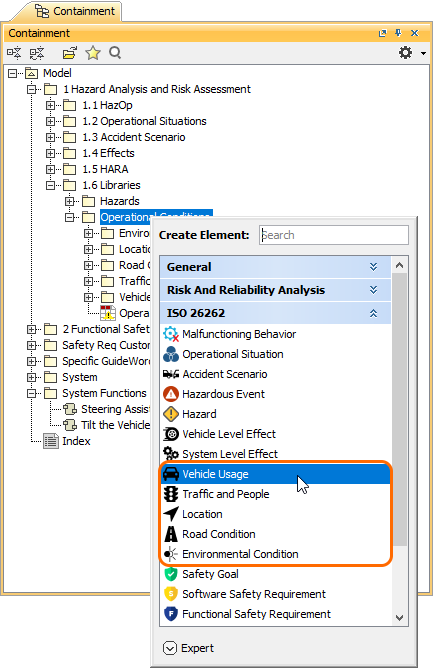On this page
An Operational Conditions Table allows you to define and manage various Operational Conditions that will be used as a part of an Operational Situation. Essentially, the Operational Conditions table acts as a library for functional safety analysis. To identify Operational Conditions, you can use five predefined Operational Condition groups: Location, Road Condition, Traffic and People, Vehicle Usage, and Environmental Condition. If you want to define an additional group, extend the group list by extending the ISO 26262 library.
An example of Operational Conditions Table.
Creating an Operational Conditions Table
Create an Operational Conditions Table as described below.
To create an Operational Conditions Table
- In the Containment tree, select the element that you want to be the owner of the table.
- Do one of the following:
- In the main menu, go to Diagrams > Create Diagram, then select Operational Conditions Table in the open dialog.
In the Containment tree, right-click the owner of the table, select Create Diagram and select Operational Conditions Table in the open dialog.
Enable the Expert mode
To be able to create an Operational Conditions Table, you need to enable the Expert mode.
- When the table is created, type the name of the table and press Enter.
After completing the above steps, an Operational Conditions Table with five predefined Operational Condition groups is created. The scope and element type of the table are already specified for you.
Creating Operational Conditions
There are two ways to create an Operational Condition: you can do it right in an Operational Conditions Table or in the Containment tree.
To create an Operational Condition in the Containment tree
- In the Containment tree, right-click the owner of a new element and select Create Element.
- In the open window, select the Operational Condition group (Vehicle Usage, Traffic and People, Location, Road Condition, or Environmental Condition) for which you want to create an Operational Condition.
- When an Operational Condition is created, type the name of the element and press Enter.
When you create an Operational Condition in the model browser, it is automatically added to an Operational Conditions Table if it exists.
To create an Operational Condition in an Operational Conditions Table
- In an Operational Conditions Table, select the Operational Condition group (Vehicle Usage, Traffic and People, Location, Road Condition, or Environmental Condition) for which you want to create an Operational Condition or select an existing element in that group.
- Do one of the following:
- In the table toolbar, click to create an element of the same level as the one you have selected.
In the table toolbar, click to create an element nested under the selected element.
- Type the name of the new element and press Enter.




